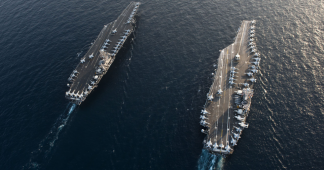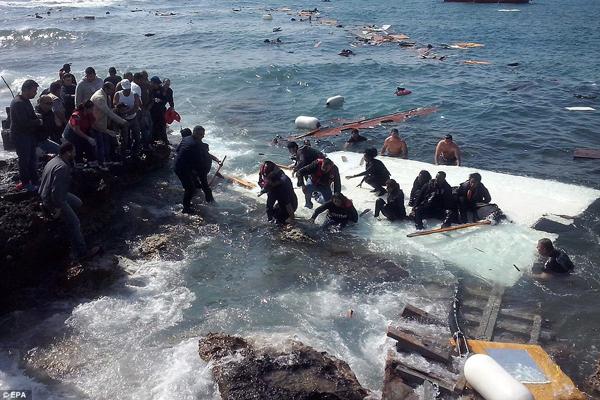14 May 19
The United States has a long history of provoking, instigating, or launching wars based on dubious, flimsy, or manufactured threats. In 1986, the Reagan Administration plotted to use U.S. military maneuvers off Libya’s coast to provoke Muammar Qaddafi into a showdown. The planning for Operation Prairie Fire, which deployed three aircraft carriers and thirty other warships, was months in the making. Before the Navy’s arrival, U.S. warplanes conducted missions skirting Libyan shore and air defenses—“poking them in the ribs” to “keep them on edge,” a U.S. military source told the Los Angeles Timesthat year. One official involved in the mission explained, “It was provocation, if you want to use that word. While everything we did was perfectly legitimate, we were not going to pass up the opportunity to strike.”
Qaddafi took the bait. Libya fired at least six surface-to-air missiles at U.S. planes. Citing the “aggressive and unlawful nature of Colonel Qaddafi’s regime,” the U.S. responded by opening fire at a Libyan patrol boat. “The ship is dead in the water, burning, and appears to be sinking. There are no official survivors,” the White House reported. In the course of two days, the U.S. destroyed two more naval vessels and a missile site in Sirte, Qaddafi’s home town. It also put Libya on general notice. “We now consider all approaching Libyan forces to have hostile intent,” the White House said.
The most egregious case was the U.S. invasion of Iraq, in 2003, which was based on bad intelligence that Baghdad had active weapons-of-mass-destruction programs. The repercussions are still playing out sixteen years (and more than four thousand American deaths) later. The beginning of the Vietnam War was authorized by two now disputed incidents involving U.S. warships in the Gulf of Tonkin. In response, Congress authorized President Johnson, in 1964, to “take all necessary measures to repel any armed attack against the forces of the United States and to prevent further aggression.” The war dragged on for a decade, claiming the lives of fifty-seven thousand Americans and as many as a million Vietnamese fighters and civilians.
The pattern goes back even further. In 1898, the Spanish-American War was triggered by an explosion on the U.S.S. Maine, an American battleship docked in Havana Harbor. The Administration of President William McKinley blamed a Spanish mine or torpedo. Almost eight decades later, in 1976, the American admiral Hyman Rickover concluded that the battleship was destroyed by the spontaneous combustion of coal in a bunker next to ammunition. In 1846, President James Polk justified the Mexican-American War by claiming that Mexico had invaded U.S. territory, at a time when the border was not yet settled. Mexico claimed that the border was the Nueces River; the United States claimed it was the Rio Grande, about a hundred miles away. One of the few voices that challenged Polk’s casus belli was Abraham Lincoln, then serving in Congress. Around fifteen hundred Americans died of battle injuries, and another ten thousand from illness.
Today, the question in Washington—and surely in Tehran, too—is whether President Trump is making moves that will provoke, instigate, or inadvertently drag the United States into a war with Iran. Trump’s threats began twelve days after he took office, in 2017, when his national-security adviser at the time, Michael Flynn, declared, in the White House press room, “As of today, we are officially putting Iran on notice.” Flynn, a former three-star general, was fired several weeks later and subsequently indicted for lying to the F.B.I. about his contacts with Russia. The Administration’s campaign against Iran, though, has steadily escalated, particularly in the past two weeks.
On May 5th, a Sunday, the White House issued an unusual communiqué—from the national-security adviser, John Bolton, not the Pentagon—announcing that a battleship-carrier strike group, led by the U.S.S. Abraham Lincoln, and a bomber task force, including B-52s, were deploying off Iran’s coast. The Lincoln was headed to the Middle East anyway, but its deployment was fast-tracked, U.S. officials told me. Bolton claimed that the Islamic Republic was engaged in “a number of troubling and escalatory indications and warnings,” but did not provide specifics. The Administration’s goal, he said, was “to send a clear and unmistakable message to the Iranian regime that any attack on United States interests or on those of our allies will be met with unrelenting force.” Bolton, who was a key player behind the U.S. war in Iraq, advocated bombing Iran before he joined the Trump White House.
Five days later, on May 10th, the Pentagon announced a second display of force: the U.S.S. Arlington and a battery of Patriot missile systems would join the Abraham Lincoln. The Arlington carries U.S. Marines and an array of aircraft, landing craft, and weapons systems to support amphibious assault, special-operations teams, and “expeditionary warfare.” A Patriot battery defends against ballistic missiles and aircraft. Both are meant to respond to “indications of heightened Iranian readiness to conduct offensive operations against U.S. forces and our interests,” the Pentagon said.
The Trump Administration is concerned that Iran, or its proxies, could strike U.S. assets in the Middle East, including in the Persian Gulf, Iraq, and Syria. The Iranians “have demonstrated the willingness and ability to attack our people, our interests, and our friends and allies in the confusing, complex zone just short of armed conflict,” General Kenneth McKenzie, the head of U.S. Central Command, said last week, at the Foundation for Defense of Democracies, in Washington.
Iran does, indeed, have a growing array of surrogates across the region. Lebanon’s Hezbollah—inspired, armed, and trained by Iran—is now the most powerful militia outside state control in the entire Middle East. In Syria, Tehran has mobilized Shiite allies from four countries—Lebanon, Iraq, Afghanistan, and Pakistan—to supplement its own forces helping President Bashar al-Assad reassert control over his fractured nation. Tehran has reportedly shipped short-range missiles to allies by boat through the Persian Gulf and deployed kits in Syria that convert imprecise rockets into missiles with greater range, accuracy, and impact. The Islamic Republic supports several Shiite militias in Iraq under the umbrella of the country’s Popular Mobilization Forces, which emerged in 2014, with Iraqi government approval, to fight ISIS. The caliphate has fallen, but the P.M.F. remains a powerful and divisive militia in Iraq.
Despite the Trump Administration’s aggressive stance, there have been no major incidents in the Persian Gulf for almost two years, after a spate of provocative acts by Iran—thirty-six in 2016 and fourteen in 2017—against U.S. warships, a Pentagon official told me. The last one was on August 14, 2017, when an Iranian drone approached the U.S.S. Nimitz as an F/A-18 was trying to land on the aircraft carrier. The drone, which was flying at night, did not have its lights on; repeated radio calls to its controlling station went unanswered. The Nimitz was in international waters, beyond the twelve-mile limit any nation can claim.
“We haven’t seen an unsafe interaction since then,” Captain Bill Urban, the spokesman for U.S. Central Command, told me. “It has been a long time, considering how many incidents we had in 2016 and 2017.” The U.S. still has regular interactions with Iranian ships. “It’s not unusual to have several attack craft come out and approach our ships and take pictures. But now they routinely stop at a safe distance or approach in manner that is not escalatory,” he said. “We continue to remain vigilant.”
The U.S. military deployments are the latest steps in the Administration’s “maximum pressure” campaign. The U.S. designated Iran’s Revolutionary Guard Corps a terrorist organization last month and has imposed a steady stream of sanctions on Iran’s economy, the most recent of which were imposed last week and covered industrial metals produced in Iran. The Administration has vowed to keep increasing pressure until Iran changes its behavior—on its weapons-development programs, human-rights violations, support for militant movements, and intervention in other Middle East countries. So far, Tehran has not changed course.
“Frustration is building up in Washington, as maximum pressure has produced minimum strategic results, and the clock is ticking,” Ali Vaez, the director of the Iran program at the International Crisis Group, told me. “Some in Washington and the region would welcome, or try to provoke, a confrontation in an effort to achieve what sanctions have failed at so far—cutting Iran down to size.” Vaez outlined two scenarios: Iran digs in, “prompting a frustrated White House to double down yet again on measures that alienate key allies and risk regional escalation,” or Iran calculates that it has little left to lose “and decides to escalate further in the nuclear realm or in the region.”
Iran has made aggressive moves of its own. Last month, Tehran threatened to close the Strait of Hormuz, through which a fifth of the world’s traded oil passes, if the Administration blocks it from exporting its own oil. Last week, President Hassan Rouhani announced that Tehran would no longer comply with two smaller provisions of the 2015 nuclear deal: exporting excess uranium and also heavy water from its nuclear program. (It might not be able to export the stockpiles anyway, since the U.S. recently vowed to sanction any country that buys either.)
Trump withdrew from the agreement a year ago, but Iran continued to comply, according to inspectors at the International Atomic Energy Agency. Rouhani also issued an ultimatum to the deal’s other five signatories, Britain, China, France, Germany, and Russia: either help Iran sell its oil and circumvent U.S. sanctions restrictions within sixty days or Tehran would increase its enrichment of uranium, a fuel that can be used for both peaceful nuclear energy and building the world’s deadliest weapon. Rouhani’s announcement basically put the world on notice that Tehran would not keep to the agreement’s limits if it failed to receive its promised benefits. “We felt that the nuclear deal needs a surgery, and the painkiller pills of the last year have been ineffective,” Rouhani said, in a televised address. “This surgery is for saving the deal, not destroying it.”
The sense of foreboding is tangible, the threats from both sides are no longer rhetorical. Before the nuclear-deal negotiations began, in 2013, Washington was consumed with hyped talk of the United States or its allies bombing Iran. If the nuclear deal formally dies, talk of military confrontation may again fill both capitals—even if neither country wants it. “Make no mistake, we’re not seeking a fight with the Iranian regime,” McKenzie, the Centcom commander, said last week. “But we do have a military force that’s designed to be agile, adaptive, and prepared to respond to a variety of contingencies in the Middle East and around the world.” The problem, as U.S. history proves, is that the momentum of confrontation is harder to reverse with each escalatory step.











